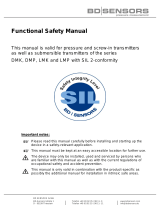If the internal diagnosis system detects a failure,the measuring
system goes into fault mode.
Adangerous undetected failure exists if the measuring system
switches neither to the defined safe condition nor to the failure
mode when the process requires it.
If the measuring system delivers output currents of "fail low"or
"fail high",it can be assumed that there is a malfunction.
The processing unit must therefore interpret such currents as a
malfunction and output a suitable fault signal.
If this is not the case,the corresponding portions of the failure
rates must be assigned to the dangerous failures.The stated
values in chapter "Safety-relevant characteristics"can thus
worsen.
The processing unit must correspond to the SIL level of the
measurement chain.
If the demand rate is only once a year,then the measuring
system can be used as safety-relevant subsystem in "low
demand mode"(IEC 61508-4,3.5.12).
If the ratio of the internal diagnostics test rate of the measuring
system to the demand rate exceeds the value 100,the
measuring system can be treated as if it is executing a safety
function in the mode with low demand rate (IEC 61508-2,
7.4.3.2.5).
An associated characteristic is the value PFD
avg
(average
Probability of dangerous Failure on Demand). It is dependent
on the test interval T
Proof
between the function tests of the
protective function.
Number values see chapter "Safety-related characteristics".
If the "low demand rate"does not apply,the measuring system
as safety-relevant subsystem in "high demand mode"should
be used (IEC 61508-4,3.5.12).
The fault tolerance time of the complete system must be higher
than the sum of the reaction times or the diagnostics test
periods of all components in the safety-related measurement
chain.
An associated characteristic is the value PFH (failure rate).
Number values see chapter "Safety-related characteristics".
Configuration of the process-
ing unit
Low demand mode
High demand mode
6VEGAPULS series 60 -4…20 mA/HART
Functional safety
31338-EN-070510





















